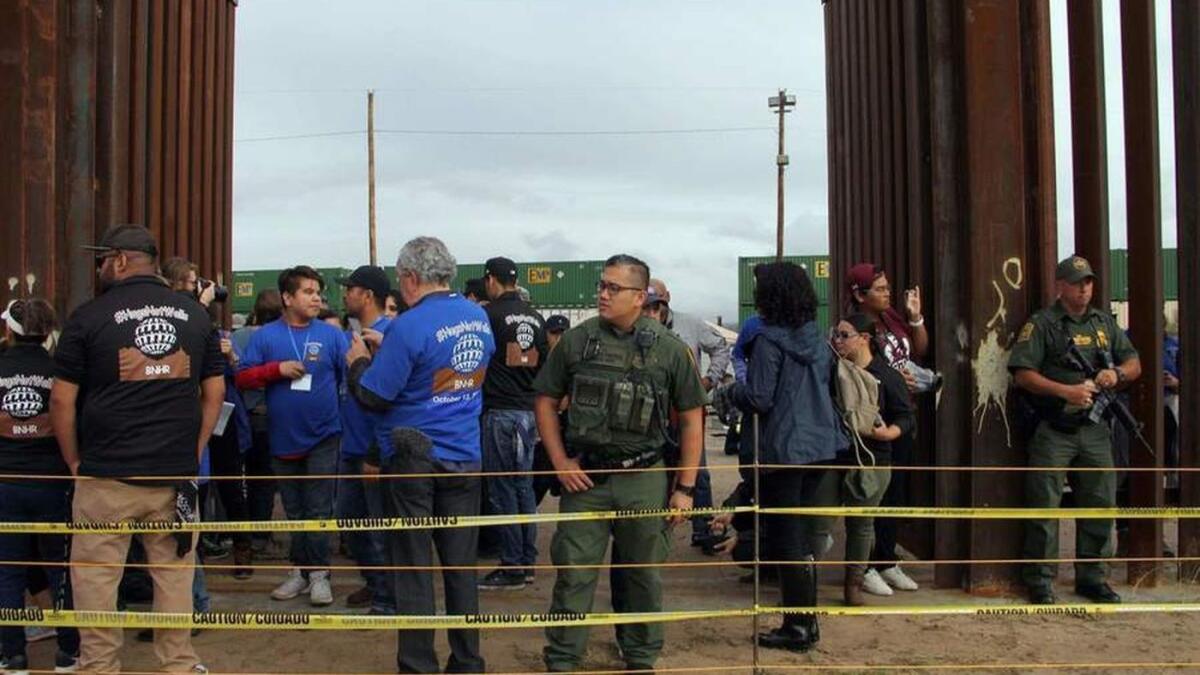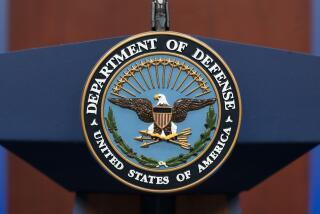Pentagon will send thousands of additional troops to the border

Reporting from Washington — The Trump administration ordered 5,200 additional troops to the Southwest border Monday, more than doubling the military presence there and widening the Pentagon’s role in domestic policing operations.
The move is in response to a caravan of Central American migrants who may seek to enter the United States through Mexico, officials said. President Trump has characterized the group as an “invasion” and falsely claimed it included terrorists and was organized by Democrats handing out money, despite denials by national security experts.
Trump’s critics dismissed the unusually heavy deployment of military troops to assist in border protection as a political ploy by the administration to appeal to its base ahead of the Nov. 6 midterm election.
The armed troops will help the Border Patrol “harden points of entry and address key gaps around points of entry” to keep members of the caravan from crossing the border, Gen. Terrence O’Shaughnessy, head of the U.S. Northern Command, said at a news conference with the Border Patrol.
The rapid timetable of the operation would have the 5,200 troops in place by the end of the week. The caravan of approximately 3,500 migrants is still moving through southern Mexico, about 900 miles from the U.S. border, and is steadily declining in numbers.
Trump has seized on the immigration issue ahead of next week’s midterm election, even though illegal immigration this year is on pace to be lower than in all but four of the previous 45 years.
The president has tweeted repeatedly about the threat posed by the caravan, a characterization that may have played a role in Saturday’s deadly synagogue attack in Pittsburgh. In online postings, the purported shooter, Robert Bowers, accused Jewish groups of aiding “invaders” by helping immigrants and refugees settle in the United States.
Though Pentagon officials in the past have emphasized that the military was playing only a supporting role in assisting civilian authorities along the border, O’Shaughnessy portrayed the military as taking a far more active operational role.
“As we sit here today, we have about 800 soldiers that are on their way right now. They’re coming from from Ft. Campbell. They’re coming from Ft. Knox. They’re moving closer to the border” and are “ready to be employed on the border.”
The first wave of 800 troops will be followed in coming days by additional deployments in Arizona and California. They will include active-duty military personnel from three combat engineering battalions and three helicopter units.
About 2,000 National Guard troops are already assisting at the border under a previous Pentagon operation.
Among other roles, Black Hawk helicopters equipped with night sensors will be available to ferry Border Patrol personnel “exactly where they need to be” to “spot groups” and “to fast-rope down” to intercept migrants trying to cross the border. Military aircraft will conduct surveillance.
The Pentagon is also sending engineers who could build vehicle barriers, walls and razor-wire fencing around the entry points. Soldiers arriving at the border were bringing 22 miles of concertina wire and would have another 150 miles available, O’Shaughnessy said.
The Pentagon is sending riot gear, ready-to-eat meals and tents to equip, feed and house additional Border Patrol agents sent to the border.
In addition, the Pentagon is sending four larger transport planes, including three C-130s and a C-17 to ferry the agency personnel to spots along the border where migrants may seek to cross illegally, officials said.
Customs and Border Protection Commissioner Kevin McAleenan said that the agency is tracking two large groups of between 3,000 and 3,500 migrants each in southern Mexico. He said the groups were preparing to enter the United States within the next few weeks.
The Pentagon and the Border Patrol are focusing initially on building up security measures at points of entry across the border, McAleenan said.
If the migrants seek to cross the border at more remote locations, the Border Patrol has an additional 830 agents to move to those locations with military assistance, he said. The agency also has two dozen of its aircraft patrolling the Southwest border, he added.
Asked why so many troops were needed, McAleenan said migrant groups that had crossed the Guatemalan-Mexico border had recently used “violent tactics” to overwhelm border guards who attempted to block them.
Trump and Homeland Security Secretary Kirstjen Nielsen have vowed to stop the caravan, but it’s been unclear whether the Border Patrol would be able to cope, given an influx of asylum-seeking families this year that recently accelerated.
“As the president and Secretary Nielsen have made clear, we will not allow a large group to enter the United States in an unsafe and unlawful manner,” McAleenan told reporters.
In recent days, the Border Patrol had deployed 100 “special response team operators” to prepare plans to beef up security at each of the 26 points of entry along the border, he said. An additional 1,000 officers, including 250 with training in riot control, are ready to move to the border as well, he said.
But the agency sought assistance from the Pentagon “due to the large size of the potential caravans that may arrive,” McAleenan said.
The Pentagon deployment — up from an original estimate of 800 that officials said was likely last week — would be double the 2,500 U.S. troops in Syria. Critics called the operation a politically motivated misuse of American military.
“The men and women of the U.S. military work hard to protect us from real threats. It is beyond cynical, and sets a terrible precedent, to exploit them for political stagecraft in the run-up to an election,” said Adam Isacson, director for defense oversight at the Washington Office on Latin America, an advocacy group that focuses on Latin America.
“The migrant caravan is mostly children and families. Most plan to ask for asylum if they make it to the U.S. border, and most will not make it. By the time they get here, the so-called caravan may be just a few hundred people. Unless soldiers are being trained to fill in asylum forms and to care for kids and moms, this is the very opposite of what the U.S. military’s mission is,” he added.
O’Shaughnessy said the Pentagon was carrying out Trump’s wishes. “I think the president has made it clear that border security is national security,” he said, adding that “our orders are very clear: We’re going to secure the border.”
Under pressure from U.S. authorities to halt the northward flow of migrants, Mexican authorities have broken up one attempted migrant caravan near the country’s southern border and offered temporary residency to Central Americans who agree to remain in the country.
McAleenan urged migrants still making their way to the United States to seek asylum in Mexico, rather than attempt to cross the border. Asked whether U.S. officials would permit people in the caravan to seek asylum in the United States, he said, “You can only process a certain number of people at a time.”
The troops will not be involved in interacting with migrants seeking to cross the border, the officials said. Using troops in a support role means they would not violate the Posse Comitatus Act, which bars the federal government from using the military for domestic policing.
But the heavier support role suggests that military personnel may come in closer contact with migrants than they have in other recent operations.
The Pentagon is sending active-duty troops, rather than National Guard soldiers, because they can mobilize faster and have more aircraft than reservists, officials said. Use of active-duty troops also enables the Trump administration to bypass California Gov. Jerry Brown, who has resisted use of troops along the border in the past.
The Pentagon operation is limited to 45 days, meaning the troops would depart in December unless the mission is extended, officials said.
Twitter: @davidcloudLAT
UPDATES:
5:25 p.m.: This article was updated with comments from the news conference and other reaction.
This article was originally published at 11:30 a.m.
More to Read
Sign up for Essential California
The most important California stories and recommendations in your inbox every morning.
You may occasionally receive promotional content from the Los Angeles Times.











